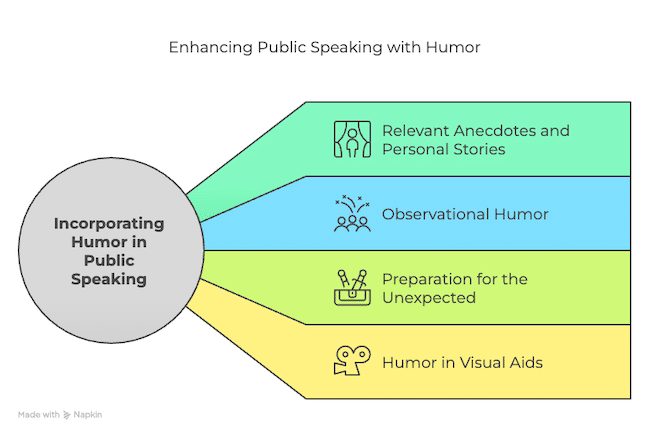Best Noise-Canceling Headphones for Writers: Enhance Focus and Creativity
The Power of Laughter: Incorporating Humor in Public Speaking

Do you remember the last genuinely engaging speech you heard? Chances are, the speaker made you laugh at least once. It's no coincidence that the most impactful public speakers—from business executives to educators—know how to incorporate humor in their presentations.
But effectively using humor is more art than science, requiring emotional intelligence and a keen understanding of your audience.
Humor has the power to transform nervous speakers into confident communicators and can turn potentially dry material into memorable content. This guide will explore why humor matters in public speaking and how to naturally incorporate it into presentations—regardless of whether one considers themselves particularly funny.
Why Incorporating Humor in Public Speaking Matters
The human brain loves novelty, and humor delivers exactly that—the unexpected twist that captures attention and creates delight. When used effectively, humor isn't just about getting laughs; it serves multiple strategic purposes:
- It lowers defenses: A laughing audience is more receptive to your message, making humor an excellent tool for persuasion.
- It builds connection: Shared laughter creates an immediate bond between speaker and audience.
- It enhances memorability: Information delivered with humor tends to stick better in the listener's mind.
- It demonstrates emotional intelligence: Using appropriate humor showcases your awareness of social dynamics.
Research consistently shows that humor can reduce hostility, deflect criticism, relieve tension, improve morale, and help communicate difficult messages. Perhaps that's why studies have found that outstanding executives use humor more frequently than their less successful counterparts. Some research even suggests a positive correlation between an executive's compensation and their skillful use of humor.
Practical Strategies for Incorporating Humor in Public Speaking
Contrary to popular belief, you don't need to be a stand-up comedian to use humor effectively. Telling formal jokes is often discouraged unless you're a professional. Instead, focus on these more natural approaches:

1. Use Relevant Anecdotes and Personal Stories
The most authentic humor springs from actual experiences that relate to your subject matter. When sharing personal stories:
- Choose anecdotes that naturally contain humor rather than forcing jokes into your content
- Ensure the story connects meaningfully to your main points
- Practice the timing and delivery of the humorous elements
As the speaking adage goes: a less funny but relevant anecdote is preferable to a fun but disconnected one. Your primary goal isn't to entertain—it's to communicate effectively, with humor serving your message.
2. Embrace Observational Humor
Observational humor—commenting on circumstances, surroundings, or shared experiences—often feels more natural than prepared jokes. This might include:
- Lighthearted observations about the venue, event, or industry
- Commentary on everyday experiences your audience will recognize
- References to current events relevant to your topic
The beauty of observational humor is its spontaneity and relatability. When Apple executive Craig Federighi presents, he often pokes fun at internal processes or makes self-deprecating remarks about his distinctive hairstyle—observations that feel authentic rather than forced.
3. Prepare for the Unexpected
Mishaps happen in public speaking—microphones fail, slides freeze, you fumble words. Having humorous remarks ready for such moments can transform potential embarrassment into audience connection:
- If technology fails: “I guess my presentation was too powerful for PowerPoint.”
- If you lose your place: “My mind just went on a quick vacation without inviting me along.”
- If there's an outside distraction: “Apparently even the construction crew next door wanted to hear this part.”
4. Build Humor Into Your Visual Aids
To inject humor, create contrasts between what you're saying and what you're showing in your visual aids:
- Use unexpected images that still relate to your point
- Create humorous comparisons through side-by-side visuals
- Include the occasional funny quote or meme (used sparingly and tastefully)
TED speaker Kevin Allocca masterfully used humorous YouTube videos to illustrate his points about viral content, making his presentation entertaining and informative.
Testing and Refining Your Approach to Humor
Even experienced speakers test their humor before using it in important presentations. Consider these practices:
- Preview with trusted colleagues: If they don't laugh, consider changing or discarding the humorous element.
- Start small: Incorporate one or two humorous elements before expanding.
- Pay attention to timing: Allow for pauses after humorous moments.
- Be authentic: Don't try to be someone you're not—use humor that feels natural to your personality.
- Consider cultural and contextual factors: Humor doesn't always translate across cultures or industries.
When and Where to Incorporate Humor in Your Speech
The strategic placement of humor can maximize its impact:
- Early in your presentation: Inject humor in the first few minutes to establish rapport and signal that your talk will be engaging.
- After making a complex point: Follow challenging information with a light moment to give the audience mental breathing room.
- During transitions: Use humor to move between sections of your presentation smoothly.
- When handling Q&A: A touch of humor can defuse tension during challenging questions.
Sir Ken Robinson, whose TED Talk on creativity in education became legendary, artfully wove anecdotes and humor throughout his presentation, particularly at transition points where audience attention might otherwise wane.
Avoiding Common Humor Pitfalls
Not all humor enhances your presentation. Be sure to avoid:
- Tired, crass, or offensive jokes: These can instantly alienate your audience.
- Humor at others' expense: Unless it's gentle self-deprecation, targeting individuals or groups is risky.
- Starting with a forced joke: Beginning with a hard pursuit of a big laugh can backfire if it falls flat.
- Satire without clear signals: Saying the opposite of what you mean requires careful execution to avoid confusion.
- Humor that undermines your credibility: Ensure your humor supports rather than detracts from your authority on the subject.
Rose George, in her TED Talk about sanitation issues (a potentially uncomfortable topic), successfully used humor not by making light of the serious subject but by not taking herself too seriously—an important distinction.
Finding Your Humor Voice
Incorporating humor in public speaking isn't about transforming into a comedian—it's about finding authentic ways to connect with your audience through shared amusement. The most effective speakers understand that humor with a genuine point can reach directly to an audience's heart.
Start by identifying humorous observations or stories from your experience that relate to your topic. Practice their delivery with trusted listeners. Pay attention to which elements get positive responses and which fall flat. Over time, you'll develop a unique, humorous voice that enhances rather than distracts from your message.
Remember: the goal isn't just laughter—it's engagement. When used thoughtfully, humor creates an environment where your audience is more receptive to your ideas and more likely to remember and act on them long after your presentation ends.
What humorous element might you incorporate in your next presentation? The journey to more engaging public speaking might begin with just one well-placed smile. Refer to our favorite books on public speaking or our list of best online courses for public speaking.
Yes! I want Bad Grammarian updates and promotions!
No Spam Zone. We will never spam or sell your email address!
Yes! I want Bad Grammarian updates and promotions!
No Spam Zone. We will never spam or sell your email address!


